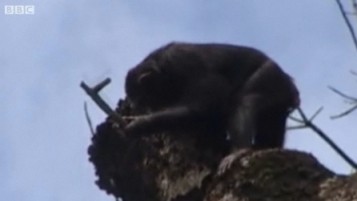It seems that new and surprising discoveries regarding the behavior, intelligence, and ingenuity of the great apes are being made on an astoundingly regular basis. This past week scientists revealed a startling discovery regarding chimpanzees. In a study published in the International Journal of Primatology, scientists in the Republic of Congo reported that wild chimpanzees arm themselves with large clubs crafted from branches to pound the nests of bees in order to gain access to the honey inside. In addition, these same chimps also put together “toolkits” made up of different sized wooden implements to help in their quest for the sweet treat.
 Primatologists have long been aware that chimps love honey and will go to great lengths to get it. Previous studies have noted how these apes fashion and shape sticks to dip into or pry open nests; however, until now, no one knew just how far chimpanzees would go to gain access to honey. Dr. Crickette Sanz, of the Max Planck Institute of Evolutionary Anthropology in Leipzig, Germany, said, “It seems these chimps in central Africa have developed more sophisticated techniques for getting at the honey than populations in eastern and western Africa – maybe it is some kind of regional feature.” He added, “These nests are tough to get into – they can be at the top of the forest canopy, at the end of a branch – and the chimps will go up there and hang at all sorts of precarious angles to get to the honey, using these clubs in any way that they can to access it.” Video footage, taken during four years of observation by researchers, shows chimpanzees pounding concrete-hard nests over 1000 times. Researchers observed some chimps take well over 1000 swings in the morning, stop and rest several hours, and then return in the afternoon to take another 1000 or so swings before finally breaking through and gaining access to the honey.
Primatologists have long been aware that chimps love honey and will go to great lengths to get it. Previous studies have noted how these apes fashion and shape sticks to dip into or pry open nests; however, until now, no one knew just how far chimpanzees would go to gain access to honey. Dr. Crickette Sanz, of the Max Planck Institute of Evolutionary Anthropology in Leipzig, Germany, said, “It seems these chimps in central Africa have developed more sophisticated techniques for getting at the honey than populations in eastern and western Africa – maybe it is some kind of regional feature.” He added, “These nests are tough to get into – they can be at the top of the forest canopy, at the end of a branch – and the chimps will go up there and hang at all sorts of precarious angles to get to the honey, using these clubs in any way that they can to access it.” Video footage, taken during four years of observation by researchers, shows chimpanzees pounding concrete-hard nests over 1000 times. Researchers observed some chimps take well over 1000 swings in the morning, stop and rest several hours, and then return in the afternoon to take another 1000 or so swings before finally breaking through and gaining access to the honey.
The chimpanzees of the Congo are also using tools of a more subtle type in their beehive raids. David Morgan, one of the co-authors of the study, from the Wildlife Conservation Society and Chicago’s Lincoln Park Zoo, said, “One of the most exciting aspects is that they are using multiple tools to access the honey that is in these hives.” Morgan and the other researchers noted the use of “toolkits” made up of the large pounding clubs, smaller and thinner “dipping wands,” and smaller sticks used for gaining enough leverage to open a hive. Researchers observed the chimps fashioning these tools and then setting them aside for later use. “They cache them in the canopy,” said Dr. Morgan. This behavior seems to point to forethought and an understanding, at least of some level, of the future. A comparable behavior was reported a few weeks ago in a study of a captive chimp, housed in the Furuvik Zoo. The chimp, named Santino, was observed collecting and fashioning throwing-sized rocks in the morning, creating a hidden cache of these rocks, and then accessing and throwing them at zoo patrons in the afternoon. It seems evident that great apes evaluate the future in ways that are much more complex than previously thought.
Considering this new information, the “wood knocking” behavior sometimes proposed for the wood ape seems all the more plausible. Even though there have been no visual reports of a wood ape hitting a large limb against a tree, this should not be surprising, given that chimpanzees, a species long known to exist, have only recently been seen whacking limbs against trees for purposes of extracting honey. It is suspected by some that wood knock sounds heard in remote wooded areas may be attributable to the wood ape; such sounds have been reported, and recorded, many times. These sounds are said to be distinctly different than the sounds of even the largest woodpeckers. Further, the sounds are often identified at night. Members of the TBRC have heard and recorded such knocks in the woods of East Texas, generally in the middle of the night in extremely remote areas where the involvement of other humans was considered highly unlikely.
The most common theory put forth by researchers who believe the wood-knocking sounds are attributable to the wood ape centers on communication as the purpose. Others have hypothesized that it is actually an attempt to intimidate and drive off intruders. Perhaps a new theory can now be offered: it is possible, after observing chimpanzees of the Congo pounding bee hives in search of honey, that the wood knocking reportedly heard on occasion in the deep woods of North America is actually an aspect of some sort of food searching activity. Could wood apes be pounding on trees in an effort to get to some sort of food source like termites or other insects? Porcupines, bears, and other animals strip bark from trees in searches for food. These animals have the benefit of claws to remove bark. Assuming the wood ape is at least as intelligent as the known great apes, and has no claws, it is not difficult to imagine individuals of the species using crude clubs to hit trees so as to gain access to whatever resources might be found inside.
With every revelation of newly observed great ape behavior and their incredible cognitive abilities, the plausibility of a rare and elusive species such as the wood ape inhabiting remote pockets of North American forests becomes increasingly augmented.
Source:
